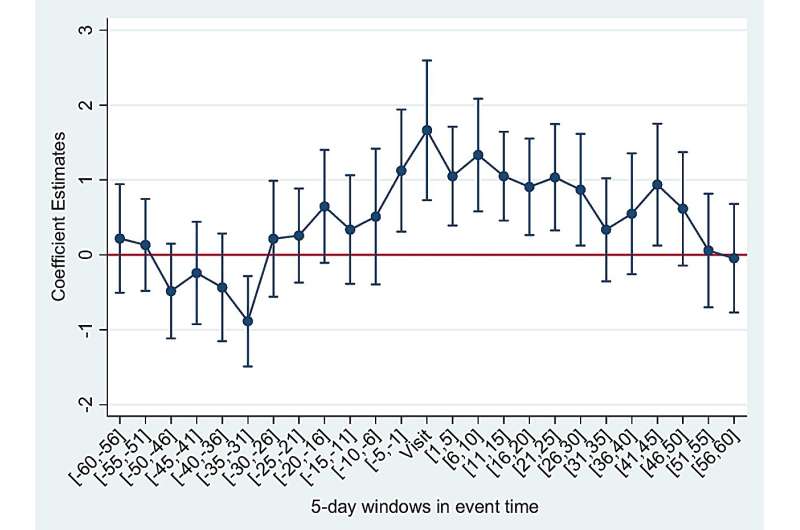This article has been reviewed according to Science X's editorial process and policies. Editors have highlighted the following attributes while ensuring the content's credibility:
fact-checked
trusted source
proofread
Manager visits heighten workers' motivation, productivity

When a company's "big boss" pays a visit to observe and connect with workers on the front lines, heightened motivation—and not necessarily the idea that they're being watched—can lead to increased productivity, a Cornell-led research team found.
In an experiment involving a Latin American bank, the researchers found that sales of credit cards, term deposits, insurance and other products increased significantly in the days immediately before and in the weeks after the division manager's visit.
"I've been a consultant and have always done field visits, and people feeling important and feeling that they are heard—it's a very strong motivator," said Asís Martínez-Jerez, professor in the Nolan School of Hotel Management, in the Cornell SC Johnson College of Business.
Martínez-Jerez is corresponding author of "Motivating From the Heights: A Field Experiment on Top Managers Visiting the Front-line," which published Aug 3 in the Review of Accounting Studies.
Co-authors are Pablo Casas-Arce, associate professor at the Carey School of Business at Arizona State University, and Joseph Moran, a doctoral student at the Wharton School, University of Pennsylvania. Their paper was dedicated to Leo Cesario, data analytics manager at the bank, who died of cancer during the study.
Martínez-Jerez's research includes management and organizations, and how philosophies and strategies find their way from the board room to the factory floor.
"The big question we are asking is, I am a CEO, but I'm not the one in contact with the client," he said. "How do I design my organization so the people on the front line react to the customer in the way that I would as a CEO?"
One of the ways to accomplish this, Martínez-Jerez said, is "managing by walking around"—visiting those in the trenches to observe, offer support and show that management cares about its employees.
To test their theory, Martínez-Jerez and his team conducted a field experiment in the retail division of a medium-size bank in Latin America. The bank was in the middle of a "tournament" in which nearly half of its 170 branches were vying for prizes based on hitting sales goals, but Martínez-Jerez didn't think the tournament aspect skewed his results.
"Our feeling was, 'Let's do it at a moment when incentives are high already,'" he said. "And if we find any additional effect on productivity during this time, then we know the effect really exists."
For their experiment, the researchers coordinated with a newly hired division manager, who scheduled a series of visits to 79 of the bank's branches over a three-month period. He had been on the job less than six months and was using these visits to introduce himself and express his pride at being part of the team.
The researchers conducted mathematical modeling as a way to gauge the motivational effects of the branch visits. Based on their modeling, they developed two hypotheses: When a top manager visits the rank and file, the team members of the front-line location increase their effort; and the incentive effect of the top manager's visits is higher for branches with good past performance than for branches with poor past performance.
The researchers obtained sales information for each branch from the data analytics department of the bank, and found that sales productivity—as measured by the percentage above sales goals for credit cards, insurance and other products—increased significantly in the days immediately before a visit, and for approximately a month afterward.
The team conducted field interviews and determined that increased motivation, including the anticipatory effects of the visit beforehand, was the reason for the improved performance. It also explained why branches that performed better prior to the visits saw a bigger increase in productivity than poorer-performing ones, which would have benefitted more from visits that included a teaching or monitoring component.
Martínez-Jerez thinks companies would generally benefit from "managing by walking around," and doesn't think the effect would dampen with repeated visits.
"We think that there is going to be an optimal cadence of visits," he said. "You have to keep the flame alive; your workers cannot feel forgotten."
More information: Pablo Casas-Arce et al, Motivating from the heights: a field experiment on top managers visiting the front-line, Review of Accounting Studies (2024). DOI: 10.1007/s11142-024-09847-3
Provided by Cornell University





















